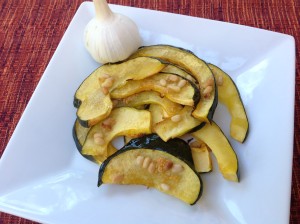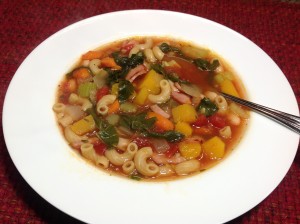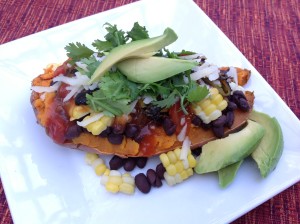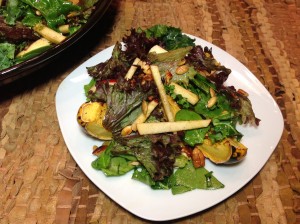 Do you “eat with the seasons?”
Do you “eat with the seasons?”
If not, we highly recommend giving it a try! Just when you have been enjoying summer produce such as zucchini, melons, okra, tomatoes and peppers until you can’t take it anymore, the calendar transitions from summer to fall, and your cravings for Fall produce kick into high gear…foods like acorn squash, butternut squash, Brussels sprouts, pears, pomegranates, parsnips and so many more. Eating with the seasons can be truly life-changing!
When it comes to Fall produce, we are frequently asked questions such as “what do you do with butternut squash?”, “do you eat the peel of an acorn squash?”, “how do you make turnips taste good?”, and “what do you do with parsnips?”. We have got you covered with some incredibly delicious answers to questions like these…
We know we sound like a broken record on this…but do you know what else will change your life?
Roasting vegetables!
It sounds so simple, but we have literally seen it change lives in the kitchen and at the table. This is what finally got our kids to start enjoying more vegetables…and I mean all kinds of vegetables. A question we get all the time is “what do you do with (fill in the vegetable)?” Our response is always: “Put it in the oven and roast it.” Especially if you have picky eaters who THINK they don’t like vegetables!
If your goal is to eat healthier while still enjoying delicious food, you are in luck…this is the perfect time of the year to do just that. The wide variety of Fall and early winter produce are fantastic roasted in the oven.
Eat the peel!
 One of our first experiences with roasting vegetables was Roasted Acorn Squash.
One of our first experiences with roasting vegetables was Roasted Acorn Squash.
These tender, sweet slices of acorn squash, (with the peel!), drizzled with olive oil and popping with the flavor of garlic and toasted pine nuts make a melt-in-your-mouth, delectable side dish…and it’s super-easy!
So, for a refresher crash-course…what does it mean to “roast?”
Roasting is a dry heat cooking method where the indirect heat in the oven cooks the food evenly on all sides. Low-temperature roasting works well for meat, but vegetables benefit most from higher temperatures, such as 400 degrees or more. When vegetables are cooked in the oven (with a little fat, like olive oil), they caramelize, turn golden brown and the flavors are greatly enhanced and intensified.
What’s the difference between baking and roasting?
Both baking and roasting happen in the oven. The primary difference is roasting is done with foods that begin with a solid structure (such as meats and vegetables), whereas baking involves foods that develop a solid structure as they cook (such as cakes or muffins). Roasting vegetables is typically done at higher temperatures than baking. Roasted foods typically include a fat (such as olive oil) on the outside to help with the browning and caramelization as they cook, whereas baked foods typically have the fat incorporated inside the food.
Roasting vegetables is super simple:
The beauty of roasting vegetables is you only need olive oil, salt and pepper for simple and delicious results!
- Preheat the oven to 400 degrees.
- Place vegetables, cut into bite size pieces, in a large bowl.
- Add 1-2 Tbsp olive oil and 1/4 to 1/2 tsp of salt and pepper. Stir until well coated.
- Spread vegetables onto a baking pan in a single layer (for easy clean-up you can place foil or parchment paper on the baking pan).
- Roast for 15 minutes, remove from the oven, toss to stir, place back in the oven and roast another 10-15 minutes until browned and tender. Time will vary depending on the type and size of vegetable, but most vegetables will usually take 20-30 minutes, with the exception of asparagus…it cooks perfectly in about 10 minutes.
A few tips to remember:
- Cut vegetables in uniform size so they cook at the same rate.
- Don’t use too much oil…about 1 Tbsp per 3 cups of vegetables. The oil, such as olive oil, helps the vegetables brown evenly and faster.
- Don’t crowd the pan! You want the vegetables to caramelize…not steam!
Here are some great-tasting and creative ways to enjoy Fall produce:
Parsnips: these look like cream-colored carrots and work perfectly when cut into fries and roasted for 20-30 minutes with garlic, cumin, olive oil, salt, pepper and fresh rosemary, such as in the Parsnip Fries. They can also be added to soups and stews, such as the Slow Cooker Guinness Beef Stew, to add excellent flavor with a touch of sweetness.
Brussels sprouts: many people tell us “I never knew I liked Brussels sprouts until I put them in the oven!” Brussels sprouts can also be shredded to make The Brussels Sprouts Hash for an ideal quick and easy breakfast or dinner! See our coaching tip for more on Brussels sprouts!
 Butternut squash: we served a Butternut Squash Minestrone, loaded with vegetables and flavor, at a party and one guest said “I picked that soup to try because it looked like the healthier option, but I had NO idea it would taste THAT good!” Butternut squash is also an ideal ingredient to add to the Butternut Squash Sloppy Joes (which is one of our family’s favorites) to add sweetness without the need for ketchup, BBQ sauce or other added sugars.
Butternut squash: we served a Butternut Squash Minestrone, loaded with vegetables and flavor, at a party and one guest said “I picked that soup to try because it looked like the healthier option, but I had NO idea it would taste THAT good!” Butternut squash is also an ideal ingredient to add to the Butternut Squash Sloppy Joes (which is one of our family’s favorites) to add sweetness without the need for ketchup, BBQ sauce or other added sugars.
Turnips: we were absolutely shocked to find out how delicious turnips can taste when grilled! They caramelize and become sweet to blow that “bitter tasting vegetable” perception away! Turnips are also excellent when added to Root Vegetable Soup and Mashed Potatoes – you will never guess they are in either one of these!
Beets: if you or someone you know are thinking “I don’t like beets…they taste like dirt,” you must try roasting beets and turning them into Roasted Beet Hummus! When they are roasted with a little olive oil and balsamic vinegar, they add mind-blowing flavor when combined with a few simple hummus ingredients. We have been told “I don’t even like hummus, because it typically doesn’t have much flavor, but I LOVE this hummus!”
 Sweet Potatoes: roast them, grill them, or put them in the slow cooker. Packed with vitamins, sweet potatoes are a great alternative to regular potatoes. Once you have them roasted, store in the refrigerator and enjoy all week long in recipes like the Southwest Stuffed Sweet Potato with Southwest flavors, such as black beans, corn, and avocado, and then topped with your favorite salsa.
Sweet Potatoes: roast them, grill them, or put them in the slow cooker. Packed with vitamins, sweet potatoes are a great alternative to regular potatoes. Once you have them roasted, store in the refrigerator and enjoy all week long in recipes like the Southwest Stuffed Sweet Potato with Southwest flavors, such as black beans, corn, and avocado, and then topped with your favorite salsa.
Pears: try Roasted Brussels Sprouts with Pears and Pistachios, or put pears on a grilled pizza! You can also turn fresh in-season pears into a pear crisp or consider making a simple spinach salad with sliced pears, chopped walnuts and crumbled gorgonzola cheese.
 Apples: pair with pork chops, add to Fall inspired salads or enjoy in the Carrot Cake Overnight Oatmeal — these are great ways to get creative with apples!
Apples: pair with pork chops, add to Fall inspired salads or enjoy in the Carrot Cake Overnight Oatmeal — these are great ways to get creative with apples!
Take advantage of Fall produce while you can…and try some new ideas, especially roasting them in the oven. It just may be the game-changer you have been looking for to include more vegetables into your routine!
 LEARN MORE ABOUT THE NAPKIN!
LEARN MORE ABOUT THE NAPKIN!
Leave A Comment